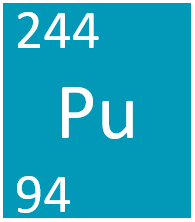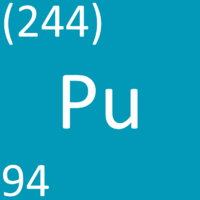Plutonium
Contents
Key Stage 2
Meaning
Key Stage 3
Meaning
Plutonium is a Actinide metal element, on the Periodic Table, with an atomic number of 94.
About Plutonium
Molecular Structure
- Plutonium has the chemical symbol Pu.
- Plutonium atoms join together in large numbers to form a giant metal molecule.
Atomic Structure
- Plutonium as 94 protons and 150 neutrons in its nucleus giving it an Atomic Number of 94 and an atomic mass of 244.
- Plutonium is in Period 7 of the Periodic Table because it has 7 electron shells.
Properties
- Plutonium is a metal element so it is a good thermal conductor and a good electrical conductor.
- Plutonium is a shiny solid at room temperature.
- Plutonium is malleable.
- Plutonium is sonorous.
- Plutonium is ductile.
Key Stage 4
Meaning
Plutonium is a Actinide metal element, on the Periodic Table, with 94 protons in the nucleus.
About Plutonium
Molecular Structure
- Plutonium has the chemical formula Pu.
- Plutonium atoms join together in a giant metallic structure.
Atomic Structure
- The most stable isotope of Plutonium has 150 neutrons in its nucleus giving it an atomic mass of 244.
- Plutonium is in Period 7 of the Periodic Table because it has 7 electron shells.
- Plutonium loses electrons to form positive metal ions.
Properties
- Plutonium forms ionic bonds with non-metals.
- Plutonium is a metal element so it is a good thermal conductor and a good electrical conductor.
- Plutonium is a shiny solid at standard temperature and pressure and has a high melting point.
- Plutonium is malleable.
- Plutonium is sonorous.
- Plutonium is ductile.
References
AQA
- Plutonium, page 128, GCSE Physics; Student Book, Collins, AQA
- Plutonium, page 37, GCSE Physics; Third Edition, Oxford University Press, AQA
- Plutonium, pages 18, 49, GCSE Physics; The Revision Guide, CGP, AQA
- Plutonium, pages 45, 55, GCSE Combined Science Trilogy; Physics, CGP, AQA
- Plutonium, pages 47, 57, 140, GCSE Physics; The Complete 9-1 Course for AQA, CGP, AQA

